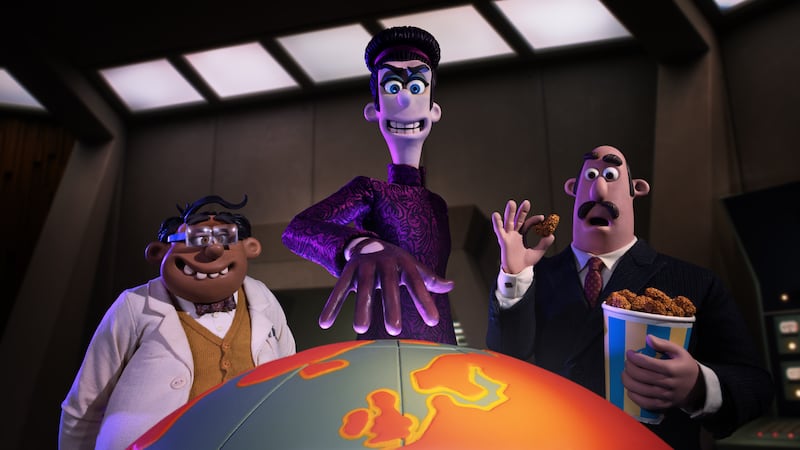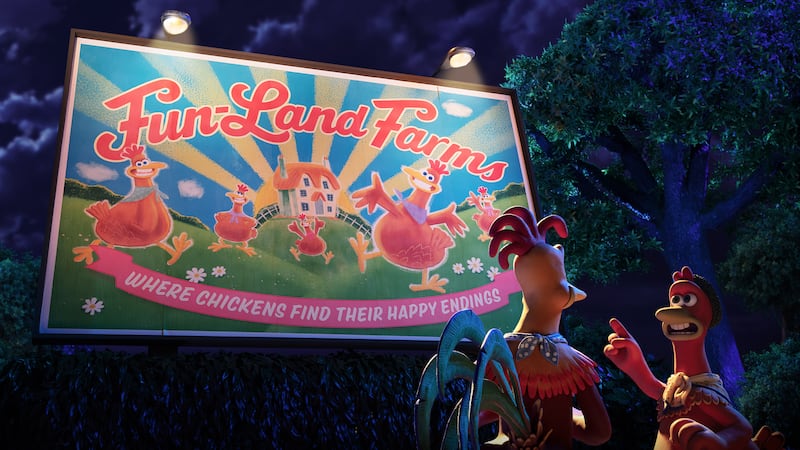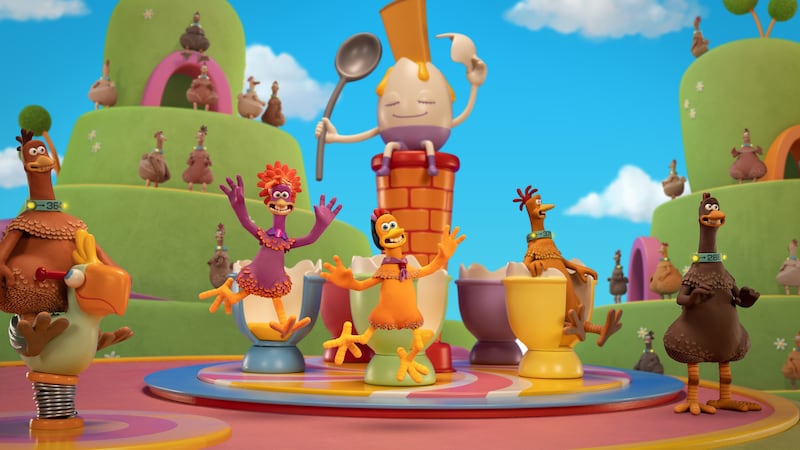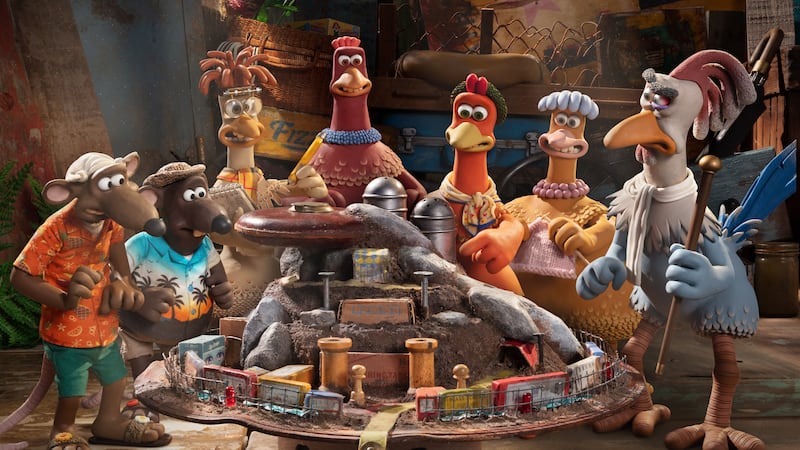From a distance, the Aardman Animations studio, which sits just off a motoway in a business park on the edge of Bristol, in southwest England, could be a furniture warehouse or a big-box store. Inside, however, it’s a marvellous warren of sets, models and problem solvers.
As we watch, a squadron of people are working across a network of stages. At one of them, director of photography Charles Copping is bouncing an amber-coloured light from a rotating and crinkled roll of tin foil to create a flame effect.
The attention to detail is astounding. Wars have been fought and won with less planning than is evident from the colour-coded production boards for Chicken Run: Dawn of the Nugget, the long-awaited sequel to the 2000 film in which doomed fowl led by a revolutionary young hen named Ginger overthrew the Tweedy family’s pie-producing empire.

Chicken Run, which was both a child-friendly tale of triumph over adversity and a sneaky riot of anti-capitalist sentiment, arrived at a moment when the muscled heroes of the 1980s and 1990s had finally lost their hold on the box office. The plot reflected as much: the action superstar Mel Gibson provided the voice for Rocky, a strutting, all-talk circus rooster who crash-lands on to the Yorkshire farm where Ginger and her feathered chums are doomed to a joyless regime of egg-laying.
READ MORE
When the Margaret Thatcher-like Mrs Tweedy acquires a chicken-pie machine, it falls to Ginger to hatch a plan. (Rocky proves a useful asset – and love interest – but is rather less heroic than he first appeared.) As Chicken Run: Dawn of the Nugget opens, Rocky and Ginger are settling into parenthood in an idyllic bird sanctuary, determined to leave their industrialised ordeal behind them. But when their adventurous daughter, Molly, spies a caravan of trucks adorned with happy chickens in buckets, she is determined to investigate.
“It took a long time to get the story right,” says Sam Fell, the new film’s director. “We spent two or three years on the story and more on the storyboards. We started with an idea about Rocky but realised it wasn’t working. Ginger is such an amazing character, so we shifted focus to her and started looking at the movie as the next chapter in her life.
“She’s gained her freedom. She’s led all the chickens where she wanted to go. Would she be comfortable in that little bubble? She’s on an island. Do she and the other chickens stay hidden or do they go out and get involved and help other chickens in the world? And then Rocky, alongside her, he was footloose and free-range and a playboy. But now he has settled down, so he’s less like the glamorous kind of movie star who arrives into the chickens’ world in the first film and more like a comic dad.”
Aardman, which has specialised in stop-motion animation ever since it created Morph for the BBC children’s programme Take Hart, in the 1970s, might normally have used some of the original Chicken Run figures, but they were destroyed in a fire in 2005. So for Dawn of the Nugget it has created every character from scratch, including, for each one, its own series of heads, beaks and eyebrows and numerous sets of eyes.
“The eyes are the soul of the puppet,” art director Matt Perry says as he stands against what must be the most colourful set in the studio’s storied history, a wonderland for chickens replete with fairground rides, multicoloured feeding stations and lush meadows.
The characters are all made from carefully selected clay: since the early 1970s Aardman has used Lewis Newplast, a modelling material named after its inventor, an art teacher from London who first concocted it in his garden shed. The studio was briefly at the centre of a “clay shortage” scare last month, after it emerged that Aardman had bought the last remaining stocks of Newplast; it says not to worry, as it has plenty left to carry on making its characters.

It’s not the only recent rumpus the animators have been involved in. Film fans will have heard that the production of Greta Gerwig’s Barbie film precipitated a shortage of the fluorescent fuchsia paint that its pink sets required. When Covid disrupted supply chains, Aardman was forced to scour the UK in search of the bright-green felt it uses as grass for its film’s Fun-Land sequence.
“The idea was to make it a rather twisted version of Butlin’s,” says production designer Darren Dubicki. “We spent a lot of time looking at Disneyland in the 1950s and 1960s, to get a feel for the rides, the shapes, the graphics and the palette. We also looked at 1960s Formica palettes and lots of pastel colours; everything is lovely and saccharine and sweet. Lightingwise, everything also needed to be completely bleached out, really quite flat, so it feels like you’ve walked into a shopping centre or a Vegas casino.”
The revolutionary spirit of the original Chicken Run was widely remarked on. “Yes, echoes of Karl Marx, Upton Sinclair, Thomas More and even classic war films abound,” one critic remarked, noting that “the main hut is number 17, as in Stalag 17”. More recently, in the sadly defunct Bitch Media, another wrote: “Ginger and her chooks taught us that collective action, coalition building, consciousness-raising, and plucky persistence are necessary ingredients for a revolution – one that hinges on rethinking our current capitalist patriarchal design.”
“A lot has happened since the last film was made,” says Fell, who also directed Flushed Away and ParaNorman. “These were powerful female characters who made the decisions. The first film had a very strong female lead. It took The Great Escape and made the Steve McQueen character female. I think now maybe the world’s changed in a way that’s finally caught up.”
If Chicken Run was modelled on classic prison-break films, Chicken Run: Dawn of the Nugget flips the formula to become a heist movie. It began with a joke, says Peter Lord, one of Aardman’s founders: “Somebody said Chicken: Impossible, and that was that.”

When Molly’s pioneering leads her to Fun-Land Farms (which turns out be to less fun than it appears), it falls to Ginger and the gang to break into the futuristic factory. We say futuristic: we mean futuristic for the 1960s. With a nod to Blofeld’s volcano lair in You Only Live Twice, Dawn of the Nugget presents the kind of factory that, at a squint, could belong to Willy Wonka or Thunderbirds-era Gerry Anderson.
“The first movie is set in the 1950s, so there’s a drab postwar look to it,” Fell says. “The new film is heading into the early 1960s. It’s the beginning of American influence coming into brands and pop culture and TV and advertising. So it’s colour and fast food. Tweedy’s farms are almost a quaint kind of organic operation. With Dawn of the Nugget, the big threat is fast food and mass production.”
That’s no jokey reference. During this year’s Super Bowl nearly 1.5 billion chicken wings were eaten across the United States – and, as a species, we breed the fowls so intensely that, with 22 billion of them across the globe, they have a combined mass that exceeds that of all other birds on Earth, according to one scientific paper. So it should come as no surprise when the new film’s goujon-minded villain announces from the sterile confines of their high-tech hideaway, “They want their food and they want it fast – and we will give it to them by the bucketload.”

There has been some controversy around the recasting of certain roles in the new film. Many members of the original voice cast, including Imelda Staunton and Lynn Ferguson, are reprising their roles. The leading roles of Rocky and Ginger, previously voiced by Mel Gibson and Julia Sawalha, are now performed by Zachary Levi and Thandiwe Newton. In 2020, Sawalha accused the film-makers of ageism. “I have officially been plucked, stuffed & roasted,” she said on social media, adding: “The reason they gave is that my voice now sounds ‘too old’.”
“Thandiwe just has a really great voice,” Fell says. “And she’s very artistic. When you work with her she’ll give you six different ways of doing something: comic, vulnerable, all these different nuances. She’s a clever actor. I never worry too much about the actor or their name or whatever. It’s always about the voice quality. Everyone was perfectly cast in the first film. But those decisions were made in 1997. That was a quarter of a century ago. Pierce Brosnan was James Bond. I personally didn’t speak to Julia. I just looked at the whole cast – because so much time has passed that this is as much a reboot as it is a sequel.”
In recent years Aardman has incorporated CGI and high-end digital tools into its film-making process, yet the day-to-day business of animation looks very similar to the earliest adventures in film-making of Lord and his fellow founder, David Sproxton, who began animating in the 1960s using cut-outs from magazines and a 16mm clockwork cine camera.
The painstaking methodology that fashioned Wallace and Gromit, the beloved inventor and his wily dog, in the 1990s defines every sequence of Chicken Run: Dawn of the Nugget. On a good day, the studio hopes to shoot four seconds of footage. (The attention Aardman pays to its work extends to the way it cleans its claymation figures: the team continue to sing the praises of Tesco’s Fred & Flo baby wipes as the only type that cleans the dust specks from its stop-motion stars without drying them out.) An opening shot of the idyllic chicken sanctuary, says animation supervisor Ian Whitlock, took six months to complete from the initial brief.
“There’s something magic about being an animator,” Lord says. “You are a god, because you make the world, and you populate it, and bring it to life.”
Chicken Run: Dawn of the Nugget is on Netflix from Friday, December 15th


















